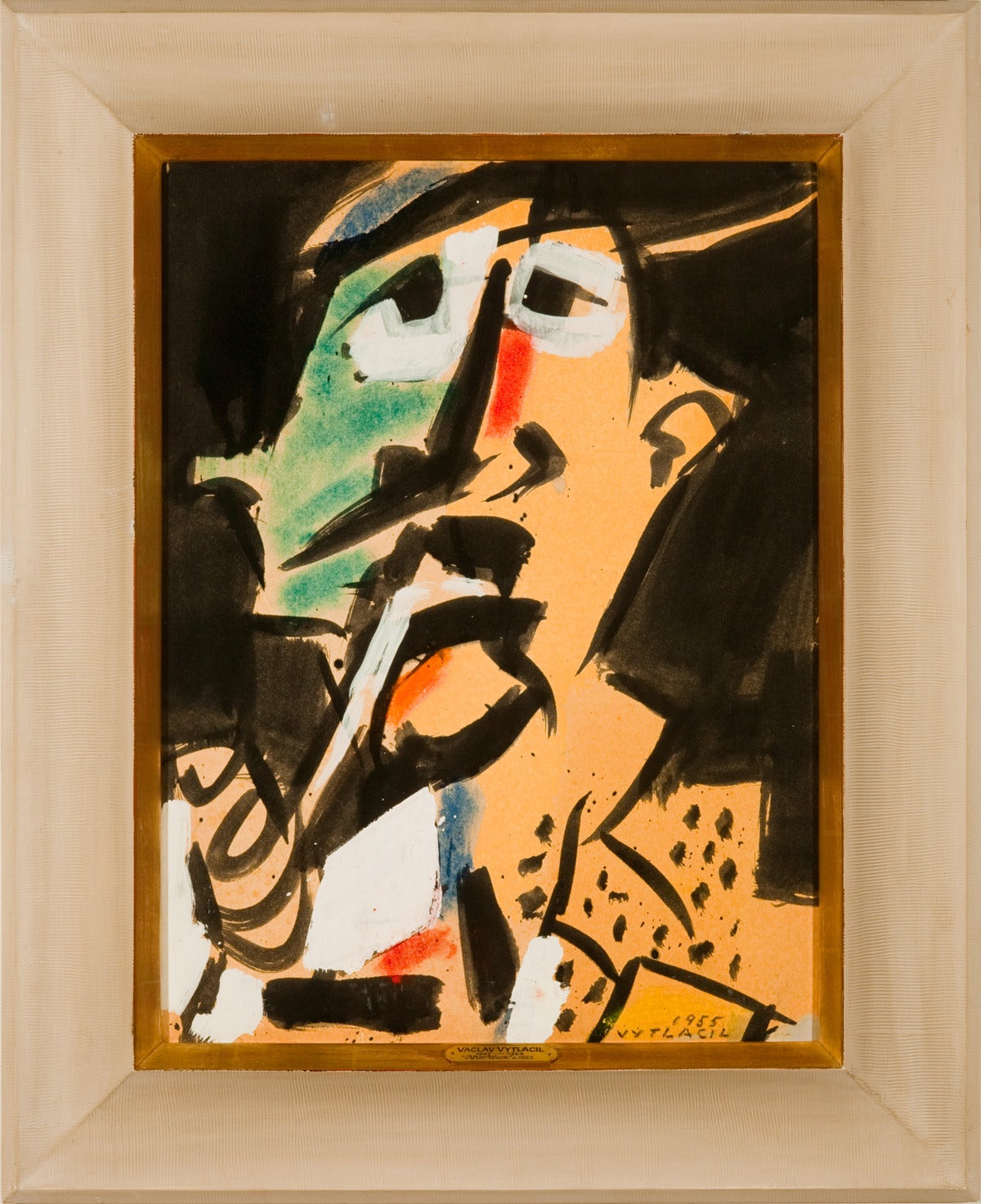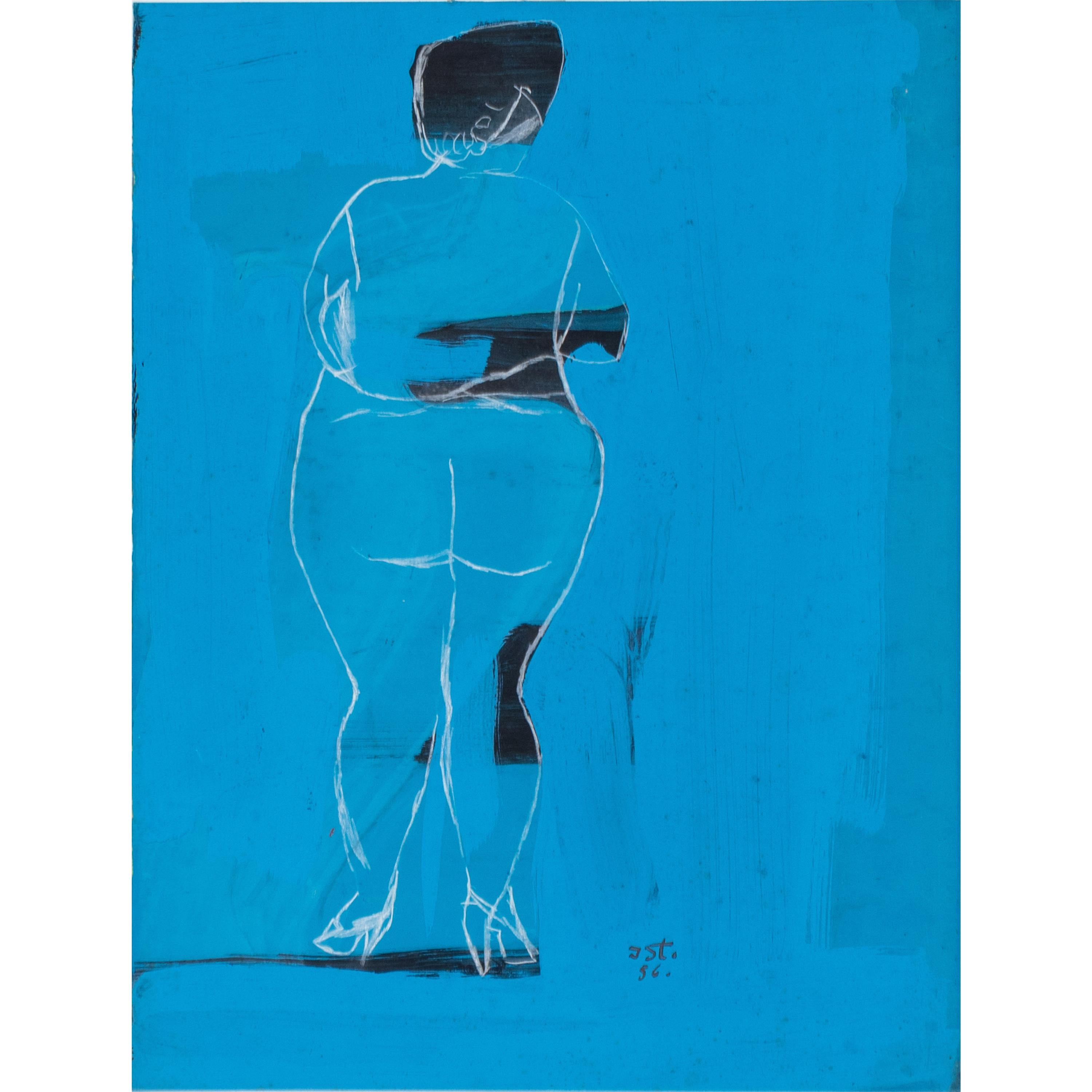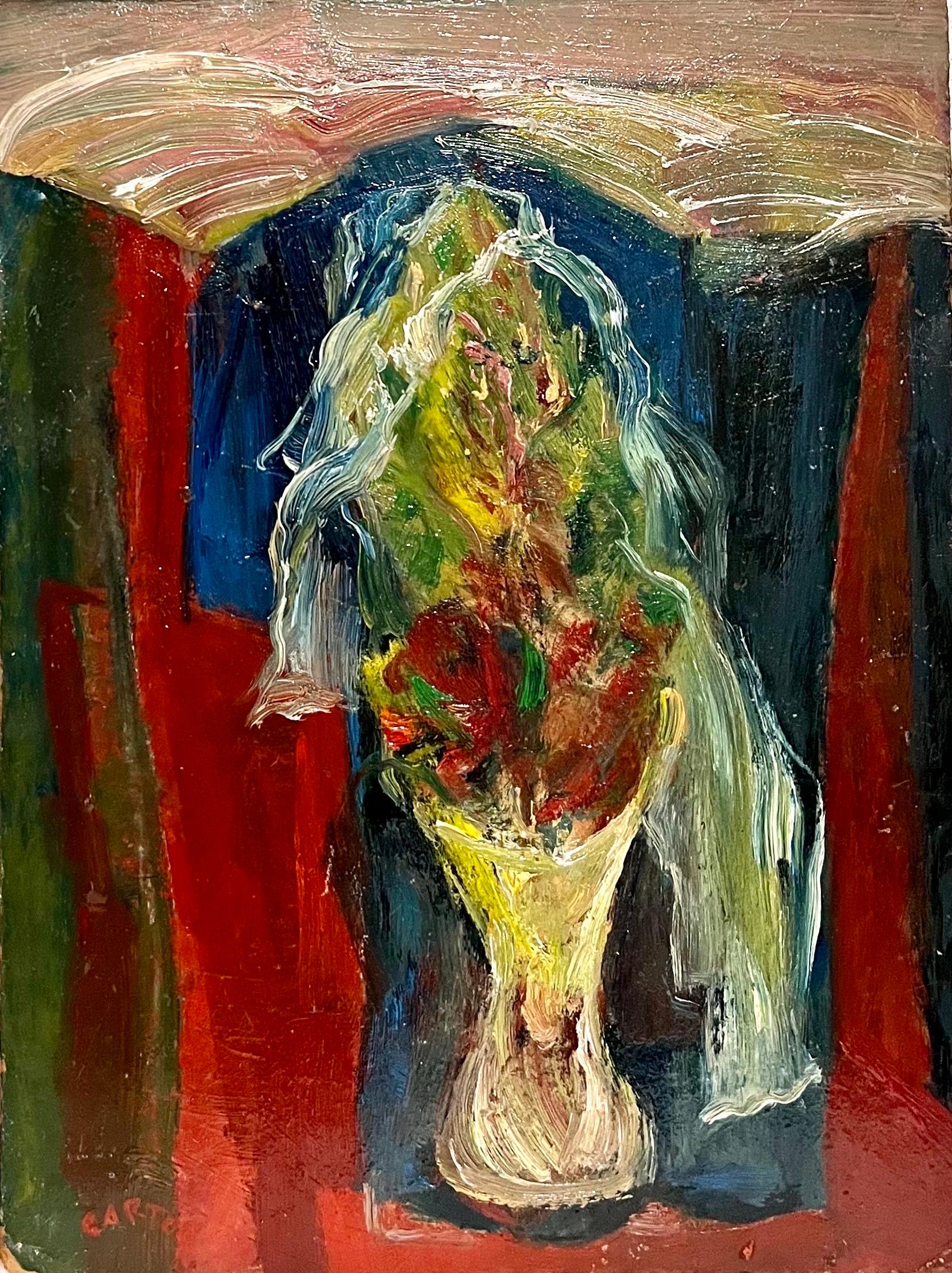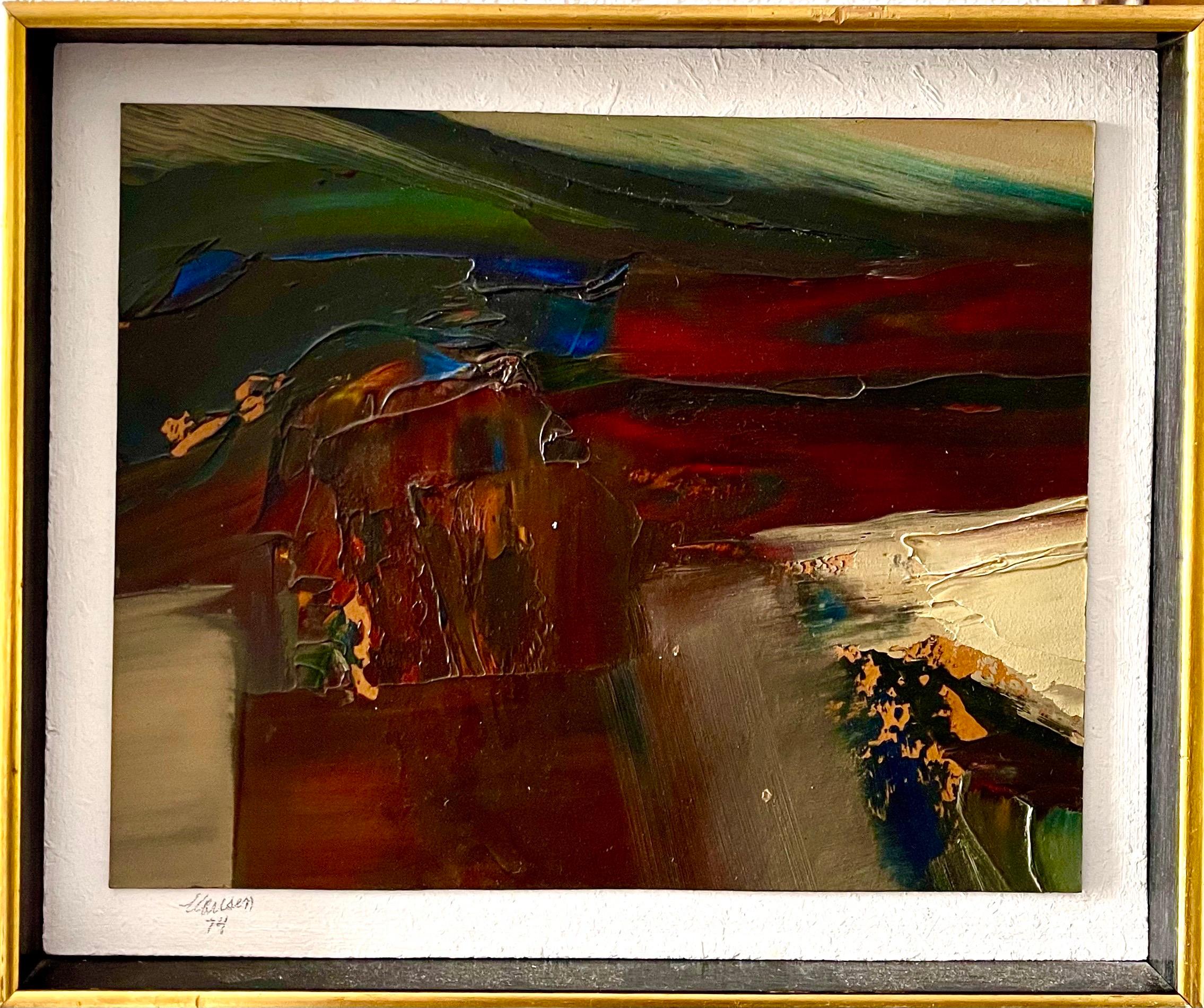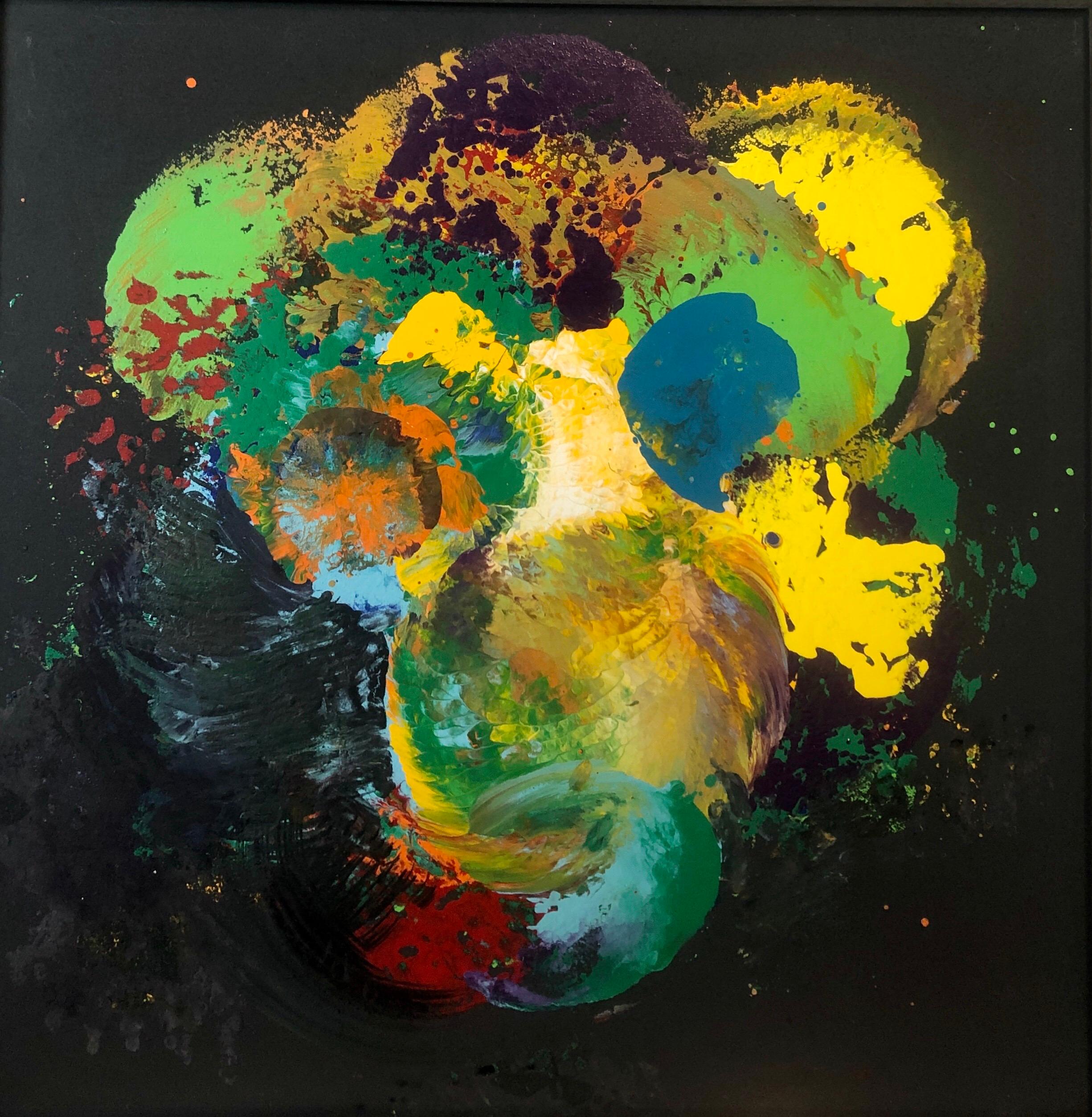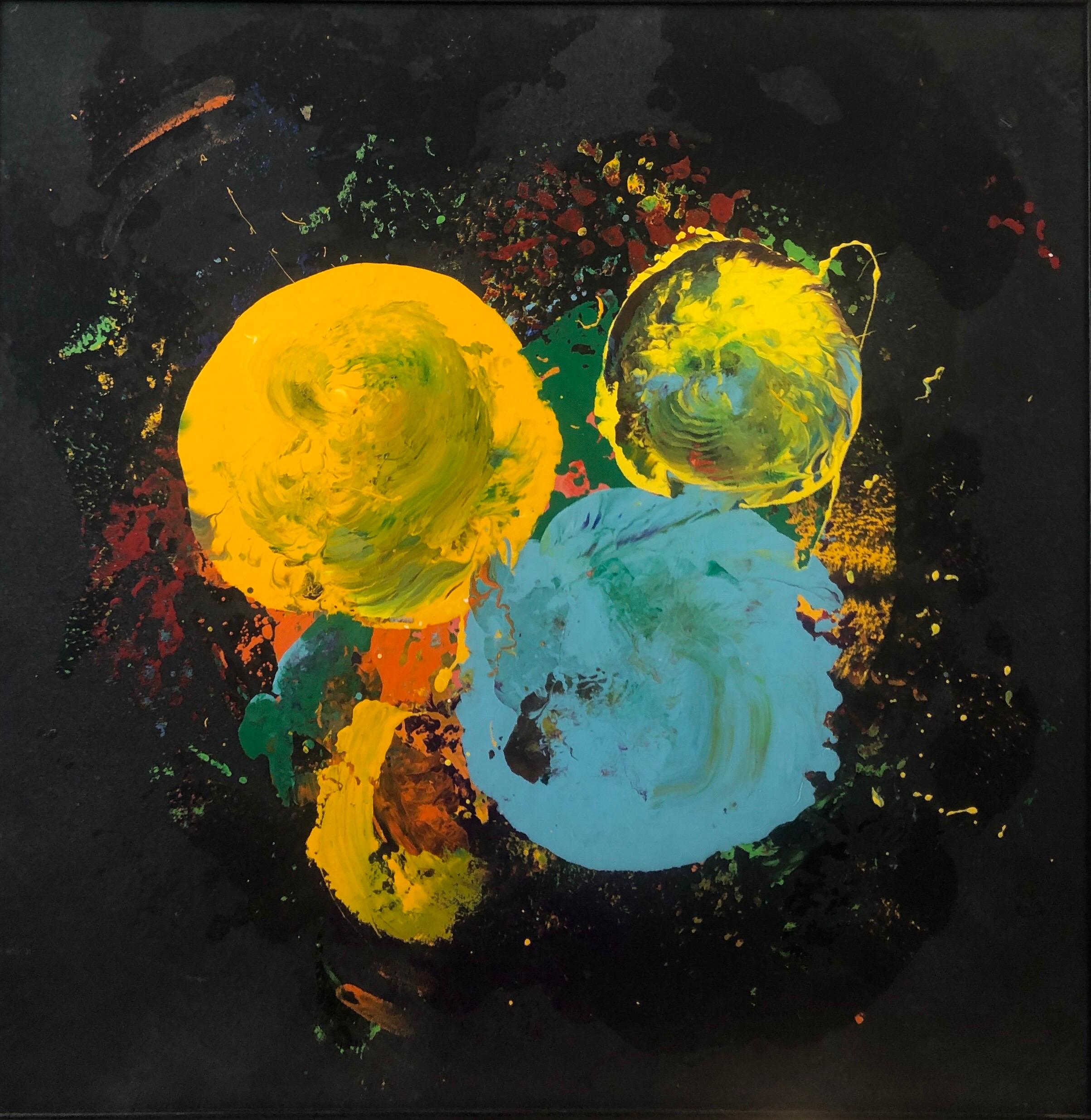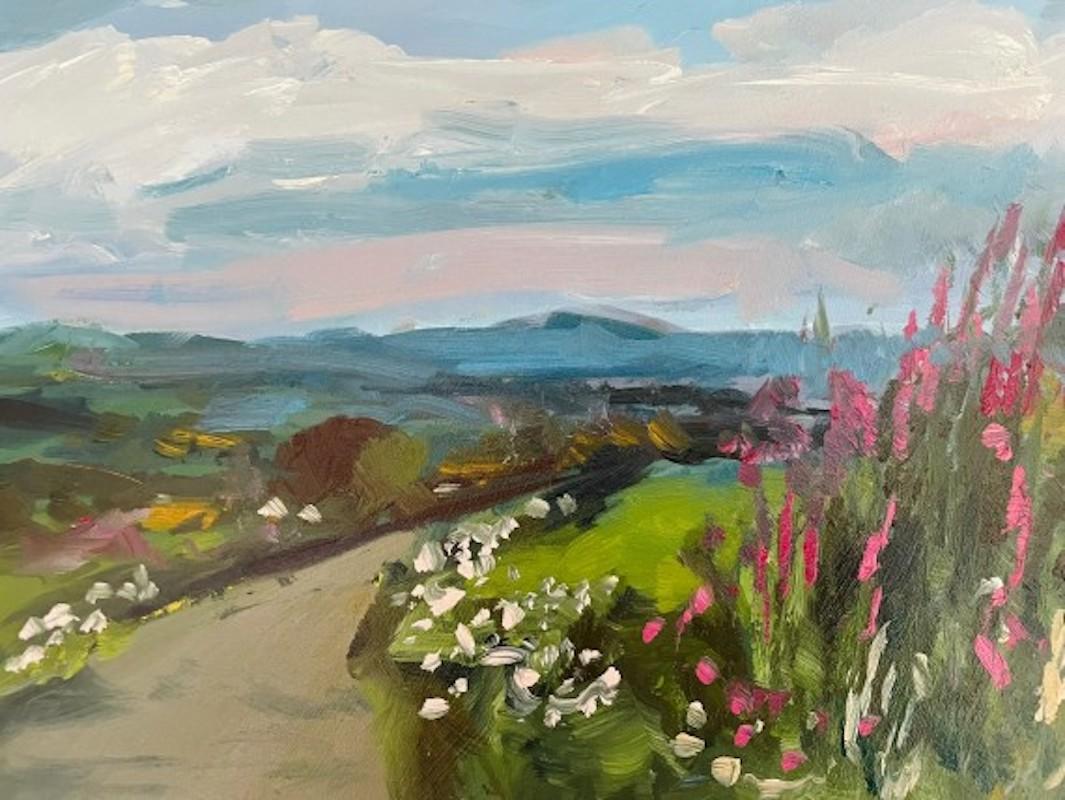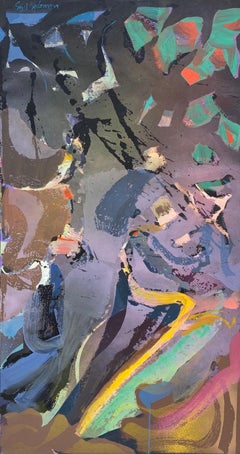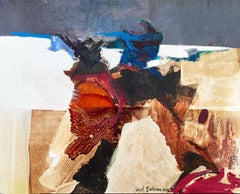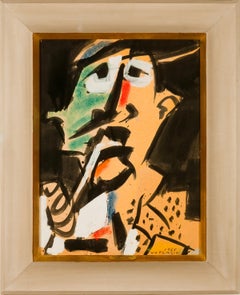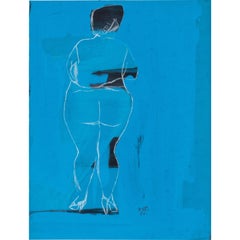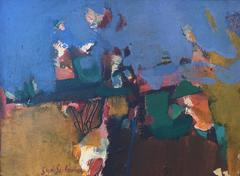
"Rosenite"
View Similar Items
Want more images or videos?
Request additional images or videos from the seller
1 of 5
Syd Solomon"Rosenite"1972
1972
About the Item
- Creator:Syd Solomon (1917, American)
- Creation Year:1972
- Dimensions:Height: 8.5 in (21.59 cm)Width: 11.5 in (29.21 cm)Depth: 2 in (5.08 cm)
- Medium:
- Movement & Style:
- Period:
- Condition:Excellent condition; original shadow box frame.
- Gallery Location:Southampton, NY
- Reference Number:1stDibs: LU1411470223
Syd Solomon
The following is from "Syd Solomon: A Retrospective Showing" exhibited at John and Mable Ringling Museum of Art and New York Cultural Center in 1975. Born Uniontown, PA 1917 Education: Art Institute of Chicago; L'Ecole des Beaux Arts in Paris.
Teaching: Pittsburgh Art Institute; Ringling Museum of Art; Sarasota School of Art; Famous Artists School; New College in Sarasota; Visiting Instructor at University of Illinois in Urbana; Visiting Professor at Roberson Center for the Arts in Binghamton, NY; Visiting Artist at Tampa Bay Art Center. Awards: Wrote and directed original play "Off Limits", which toured in France, Belgium and Luxembourg during 1945; State Department U.S. Cultural Exchange program to Israel; Ford Foundation Special Purchase Grant for the Guggenheim Musuem. Exhibitions: Many exhibits from 1944 including Clearwater Museum of Art in Clearwater, FL; Lowe Art Gallery in Coral Gables; Associated American Artists Galleries; Saidenberg Gallery in New York; Midtown Gallery; Trend House Gallery in Florida; Brevard College; Paintings of the Circus at Sarasota Art Association; Annual Exhibition at the American Water Color Society 1955; Fifty Ninth Annual Exhibition at the National Collection of Fine Arts, Smithsonian 1956; Invitational Exhibition at the American Academy of Arts and Letters in 1959; Whitney Museum of American Art in 1964; Colorado Springs Fine Arts Center. Collections: Adelphi University; Baltimore Museum of Art; Chrysler Art Museum; Guggenheim Museum; High Museum of Art; New Orleans Museum of Art; Wadsworth Museum; Whitney Museum of American Art; Witte Memorial Museum.
About the Seller
5.0
Platinum Seller
These expertly vetted sellers are 1stDibs' most experienced sellers and are rated highest by our customers.
Established in 1977
1stDibs seller since 2013
473 sales on 1stDibs
Typical response time: 1 hour
More From This SellerView All
- “Lightride”By Syd SolomonLocated in Southampton, NYHere for your consideration is a great example of the artwork of the well known American artist, Syd Solomon. Signed top left. Titled and dated verso 1978. The painting is oil and acrylic paint on mounted synthetic canvas. Condition is excellent. Overall framed measurements are 44.75 by 24.5 inches. Provenance: A Sarasota, Florida collector. SYD SOLOMON BIOGRAPHY American 1917-2004 Written by Dr. Lisa Peters/Berry Campbell Gallery “Here, in simple English, is what Syd Solomon does: He meditates. He connects his hand and paintbrush to the deeper, quieter, more mysterious parts of his mind- and he paints pictures of what he sees and feels down there.” --Kurt Vonnegut Jr. from Palm Sunday, 1981 Syd Solomon was born near Uniontown, Pennsylvania, in 1917. He began painting in high school in Wilkes-Barre, where he was also a star football player. After high school, he worked in advertising and took classes at the Art Institute of Chicago. Before the attack on Pearl Harbor, he joined the war effort and was assigned to the First Camouflage Battalion, the 924th Engineer Aviation Regiment of the US Army. He used his artistic skills to create camouflage instruction manuals utilized throughout the Army. He married Ann Francine Cohen in late 1941. Soon thereafter, in early 1942, the couple moved to Fort Ord in California where he was sent to camouflage the coast to protect it from possible aerial bombings. Sent overseas in 1943, Solomon did aerial reconnaissance over Holland. Solomon was sent to Normandy early in the invasion where his camouflage designs provided protective concealment for the transport of supplies for men who had broken through the enemy line. Solomon was considered one of the best camoufleurs in the Army, receiving among other commendations, five bronze stars. Solomon often remarked that his camouflage experience during World War II influenced his ideas about abstract art. At the end of the War, he attended the École des Beaux-Arts in Paris. Because Solomon suffered frostbite during the Battle of the Bulge, he could not live in cold climates, so he and Annie chose to settle in Sarasota, Florida, after the War. Sarasota was home to the John and Mable Ringling Museum of Art, and soon Solomon became friends with Arthur Everett “Chick” Austin, Jr., the museum’s first Director. In the late 1940s, Solomon experimented with new synthetic media, the precursors to acrylic paints provided to him by chemist Guy Pascal, who was developing them. Victor D’Amico, the first Director of Education for the Museum of Modern Art, recognized Solomon as the first artist to use acrylic paint. His early experimentation with this medium as well as other media put him at the forefront of technical innovations in his generation. He was also one of the first artists to use aerosol sprays and combined them with resists, an innovation influenced by his camouflage experience. Solomon’s work began to be acknowledged nationally in 1952. He was included in American Watercolors, Drawings and Prints at the Metropolitan Museum of Art, New York. From 1952–1962, Solomon’s work was discovered by the cognoscenti of the art world, including the Museum of Modern Art Curators, Dorothy C. Miller and Peter Selz, and the Whitney Museum of American Art’s Director, John I. H. Baur. He had his first solo show in New York at the Associated American Artists Gallery in 1955 with “Chick” Austin, Jr. writing the essay for the exhibition. In the summer of 1955, the Solomons visited East Hampton, New York, for the first time at the invitation of fellow artist David Budd...Category
1970s Abstract Expressionist Abstract Paintings
MaterialsCanvas, Oil, Acrylic, Board
$28,000 - “Dune Watch”By Syd SolomonLocated in Southampton, NYHere for your consideration is a very well executed early abstract painting by the well known American artist, Syd Solomon. Oil paint on birch ply panel. Signed middle bottom. Signed, titled and dated 1966 verso. The painting was done in East Hampton, New York where Syd Solomon spent his summers. Condition is excellent. Overall framed measurements are 26 by 31.5 inches. Provenance: A Sarasota, Florida collector. Syd Solomon was born near Uniontown, Pennsylvania, in 1917. He began painting in high school in Wilkes-Barre, where he was also a star football player. After high school, he worked in advertising and took classes at the Art Institute of Chicago. Before the attack on Pearl Harbor, he joined the war effort and was assigned to the First Camouflage Battalion, the 924th Engineer Aviation Regiment of the US Army. He used his artistic skills to create camouflage instruction manuals utilized throughout the Army. He married Ann Francine Cohen in late 1941. Soon thereafter, in early 1942, the couple moved to Fort Ord in California where he was sent to camouflage the coast to protect it from possible aerial bombings. Sent overseas in 1943, Solomon did aerial reconnaissance over Holland. Solomon was sent to Normandy early in the invasion where his camouflage designs provided protective concealment for the transport of supplies for men who had broken through the enemy line. Solomon was considered one of the best camoufleurs in the Army, receiving among other commendations, five bronze stars. Solomon often remarked that his camouflage experience during World War II influenced his ideas about abstract art. At the end of the War, he attended the École des Beaux-Arts in Paris. Because Solomon suffered frostbite during the Battle of the Bulge, he could not live in cold climates, so he and Annie chose to settle in Sarasota, Florida, after the War. Sarasota was home to the John and Mable Ringling Museum of Art, and soon Solomon became friends with Arthur Everett “Chick” Austin, Jr., the museum’s first Director. In the late 1940s, Solomon experimented with new synthetic media, the precursors to acrylic paints provided to him by chemist Guy Pascal, who was developing them. Victor D’Amico, the first Director of Education for the Museum of Modern Art, recognized Solomon as the first artist to use acrylic paint. His early experimentation with this medium as well as other media put him at the forefront of technical innovations in his generation. He was also one of the first artists to use aerosol sprays and combined them with resists, an innovation influenced by his camouflage experience. Solomon’s work began to be acknowledged nationally in 1952. He was included in American Watercolors, Drawings and Prints at the Metropolitan Museum of Art, New York. From 1952–1962, Solomon’s work was discovered by the cognoscenti of the art world, including the Museum of Modern Art Curators, Dorothy C. Miller and Peter Selz, and the Whitney Museum of American Art’s Director, John I. H. Baur. He had his first solo show in New York at the Associated American Artists Gallery in 1955 with “Chick” Austin, Jr. writing the essay for the exhibition. In the summer of 1955, the Solomons visited East Hampton, New York, for the first time at the invitation of fellow artist David Budd...Category
1960s Abstract Expressionist Abstract Paintings
MaterialsOil, Board
- “Untitled”By Iliyan IvanovLocated in Southampton, NYOriginal acrylic on fiberboard painting by the Bulgarian/American artist, Iliyan Ivanov. Signed, and dated verso, 2012. Untitled. This painting is part of the “Memories of Unfinis...Category
2010s Abstract Expressionist Abstract Paintings
MaterialsAcrylic, Fiberboard
$1,480 Sale Price20% Off - “Untitled”By Iliyan IvanovLocated in Southampton, NYOriginal acrylic on fiberboard painting by the Bulgarian/American artist, Iliyan Ivanov. Signed, and dated verso, 2012. Untitled. This painting is part of the “Memories of Unfinis...Category
2010s Abstract Expressionist Abstract Paintings
MaterialsAcrylic, Fiberboard
$1,480 Sale Price20% Off - "Red Fish"By Dina Gustin BakerLocated in Southampton, NYDina Gustin Baker studied at the Philadelphia college of Fine Art as well as the Art Students League in New York. This work acrylic on paper is evocative of her colorful palette and ...Category
1960s Abstract Expressionist Abstract Paintings
MaterialsAcrylic, Board
- “Abstract, 1954”By Irene ZevonLocated in Southampton, NYOil on canvas abstract painting by the American artist, Irene Zevon. Signed lower right and dated 1954. In very good condition. Not presently framed. Provenance: Estate of the artis...Category
1950s Abstract Expressionist Abstract Paintings
MaterialsCanvas, Oil
You May Also LikeView All
- "After Work"By Vaclav VytlacilLocated in Lambertville, NJJim’s of Lambertville is proud to offer this artwork. Signed lower right Vaclav Vytlacil (1892-1984) He was born to Czechoslovakian parents in 1892 in New York City. Living in C...Category
20th Century Abstract Expressionist Abstract Paintings
MaterialsOil, Board
- Josef Steiner (1899-1977), Abstract female nude, dated 1956By Josef SteinerLocated in Greding, DEAbstract female figure on a blue ground. Monogrammed and dated in the lower centre. Josef Steiner (1899 Munich - 1977 ibid.) lived through a Germany in all its facets as an artist. A...Category
20th Century Abstract Expressionist Nude Paintings
MaterialsOil, Cardboard
- Feelings. 2019, hardboard, oil, 39x28 cmBy Dmitry LavrentjevLocated in Riga, LVFeelings. 2019, hardboard, oil, 39x28 cmCategory
2010s Abstract Expressionist Abstract Paintings
MaterialsOil, Cardboard
$664 Sale Price25% Off - American Abstract Expressionist Flowers Oil Painting Norman Carton WPA ArtistBy Norman CartonLocated in Surfside, FLNorman Carton (1908 – 1980) was an American artist and educator known for abstract expressionist art. He was born in the Ukraine region of Imperial Russia and moved to the United States in 1922 where he spent most of his adult life. A classically trained portrait and landscape artist, Carton also worked as a drafter, newspaper illustrator, muralist, theater set designer, photographer, and fabric designer and spent most of his mature life as an art educator. Carton showed in and continues to be shown in many solo and group exhibitions. His work is included in numerous museums and private collections throughout the world. Norman Carton was born in the Dnieper Ukraine territory of the Russian Empire in 1908. Escaping the turbulence of civil war massacres, he settled in Philadelphia in 1922 after years of constant flight. While attending the Pennsylvania Museum School of Industrial Art, Carton worked as a newspaper artist for the Philadelphia Record from 1928 to 1930 in the company of other illustrator/artists who had founded the Ashcan School, the beginnings of modern American art. From 1930 to 1935, he studied at the Pennsylvania Academy of Fine Arts under Henry McCarter, who was a pupil of Toulouse-Lautrec, Puvis de Chavanne, and Thomas Eakins. Arthur Carles, especially with his sense of color, and the architect John Harbison also provided tutelage and inspiration. Following his time at the Pennsylvania Academy of Fine Arts, Carton studied at the Barnes Foundation from 1935 to 1936 where he was influenced by an intellectual climate led by visiting lecturers John Dewey and Bertrand Russell as well as daily access to Albert C. Barnes and his art collection. Carton was awarded the Cresson Traveling Scholarship in 1934 which allowed him to travel through Europe and study in Paris. There he expanded his artistic horizons with influences stemming from Henri Matisse, Pablo Picasso, Chaim Soutine, and Wassily Kandinsky. While at the Pennsylvania Academy of Fine Arts, Carton was also awarded the Toppan Prize for figure painting as well as the Thouron Composition Prize. He received numerous commissions as a portrait artist, social realist, sculptor, and theatrical stage designer as well as academic scholarships. During this time, Carton worked as a scenery designer at Sparks Scenic Studios, a drafter at the Philadelphia Enameling Works, and a fine art lithographer. From 1939 to 1942, the Works Progress Administration (WPA) Federal Art Project employed Carton as a muralist and easel artist. He collaborated with architect George Howe. The WPA commissioned Carton to paint major murals at the Helen Fleischer Vocational School for Girls in Philadelphia, the Officers’ Club at Camp Meade Army Base in Maryland, and in the city of Hidalgo, Mexico. Throughout the 1940s, Carton exhibited and won prizes for his semi-abstract Expressionist and Surrealist paintings. He socialized with and was inspired by Émile Gauguin and Fernand Leger. During World War II, Carton was a naval structural designer and draftsman at the Cramps...Category
Mid-20th Century Abstract Expressionist Still-life Paintings
MaterialsOil, Board
- 1974 California Bay Area Abstract Expressionist Bold Oil Painting Don ClausenBy Don ClausenLocated in Surfside, FLDon Clausen American (b. 1930) Untitled (1974) Oil on board Hand signed lower left and verso Framed 11.25 X 13.5 sight 9 x 11.25 inches Don Clausen is an American Postwar & Contemporary painter who was born in 1930. Don Clausen is a graduate of California College of Arts and Crafts in Oakland, California. He lives and works in the San Francisco/Oakland Bay Area. He mainly works in oils on canvas, but sometimes does sculptures and assemblages. In his luminous abstractions, Clausen employs every color of the rainbow, the strong lines forming geometric shapes that appear to fly through space. Nothing is weighed down in his paintings; it’s as if images came to him from outer space or other realms. He turns the physical world into dabs and streaks of color that convey an engulfing sense of motion. Whether abstract expressionism or representational, his works convey enormous energy and vitality, like masterpieces by Jackson Pollock and Willem de Kooning. They also are distinctive for their sculptural quality, a result of his thickly layering the paint and then slicing down to the canvas with a palette knife or section of a venetian blind; his choice of tools is as eclectic as his subject matter. His son is the well regarded sculptor Eric Clausen, a master blacksmith who does sculpture in iron. An active part of the Bay Area arts scene, Don Clausen was contemporaries and consociates of people such as Geraldine Duncann, Donald Namohala Yuen,Jade Fon...Category
1970s Abstract Expressionist Abstract Paintings
MaterialsOil, Board
- Charles Clough Picture Generation Abstract Expressionist Oil Enamel PaintingBy Charles CloughLocated in Surfside, FLThis vibrant colorful painting is fully hand signed, dated and titled verso. It might be acrylic but it looks like oil or enamel ad I have seen it described thusly. This listing is for 1 painting. the last image shows all 4 that I have hung as grouping. Charles Sidney Clough (born February 2, 1951, in Buffalo, New York) is an American painter. His art has been exhibited in over 70 solo and over 150 group exhibitions throughout North America and Europe and is included in the permanent collections of over 70 museums, including the Metropolitan Museum of Art, National Gallery of Art, and Smithsonian American Art Museum. Clough has received fellowships and grants from the New York State Council on the Arts, National Endowment for the Arts, Adolph Gottlieb Foundation, the Jackson Pollock-Lee Krasner Foundation, and the John Simon Guggenheim Foundation. Charles Clough was born and raised in Buffalo, New York where he attended Hutchinson Central Technical High School. He then attended Pratt Institute in Brooklyn from 1969-1970 where the two-dimensional design teacher Joseph Phillips, introduced Artforum magazine to him. Clough dropped out and on January 5, 1971 decided that he would devote his life to art. He traded his sculptor's assistant services for studio space with artist Larry W. Griffis Jr., at the Ashford Hollow Foundation's 30 Essex Street former ice-house facility. From 1971-1972 he attended the Ontario College of Art and was introduced to the artists and galleries of Toronto, Ontario, Canada. By 1973 many of the University at Buffalo's and Buffalo State's art professors had rented studios at 30 Essex Street. One of these, Joseph Panone, brought his student, Robert Longo and introduced him to Clough, which resulted in the program of exhibitions and artists' visits which became Hallwalls in 1974. Panone and his wife, Cindy Sherman, assisted in presenting, amongst many others, the works of Vito Acconci, Kathy Acker, Laurie Anderson, Lynda Benglis, Ross Bleckner, Barbara Bloom, Eric Bogosian...Category
1980s Abstract Expressionist Abstract Paintings
MaterialsEnamel
